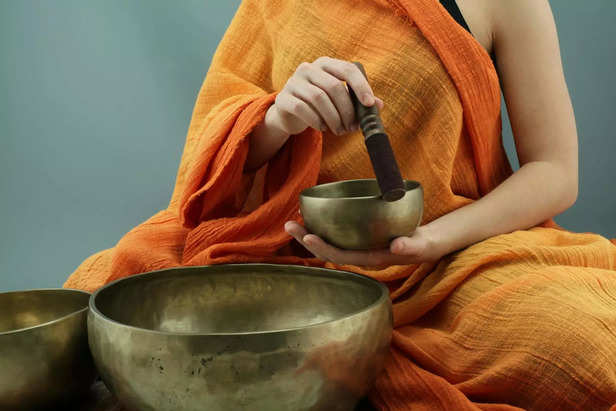Is Healing the End of Comfort? A Lesson from the Gita
Riya Kumari | Apr 23, 2025, 12:40 IST
So, picture this: You're curled up on the couch with a pint of ice cream, binge-watching something mindlessly romantic because, let’s face it, you’re just trying to avoid life for a bit. It’s cozy. It’s comfortable. You’ve hit that sweet spot where you could stay forever—except… there’s a voice inside your head that’s telling you you’re doing it all wrong. It’s that tiny, insistent voice, like the universe is texting you: “You need to grow. Heal. Move on. Be better.”
There’s a part of us, deep down, that craves comfort. It's why we seek the soft edges of our routines, why we hide behind the predictability of our lives, why we turn to things that make us feel safe, even if they don’t make us feel alive. Comfort feels like a warm blanket—familiar, cozy, reassuring. But the truth? Comfort is often a trap. It’s not the sign of success or happiness—it’s the quiet, unspoken resistance to growth. When we talk about healing, we tend to picture it like an easy cure. We want it to be this gentle process of self-care—long baths, soft pillows, and mental clarity. But in reality, healing isn’t about finding peace; it’s about embracing the discomfort that comes with real transformation. And the Gita—yes, the ancient wisdom of the Bhagavad Gita—has a lot to say about this.
Comfort as a Barrier to Growth

In the modern world, we’re told to seek comfort. We’re told that life should be easier, that we should avoid the hard things, that we deserve to feel good all the time. But what we often don’t realize is that this desire for comfort keeps us stuck. It locks us into patterns that don’t serve us. It keeps us safe, but it also keeps us small. Healing, according to the Bhagavad Gita, is not about escaping discomfort. It’s about learning to move through it.
Krishna, speaking to Arjuna in the middle of a battlefield, offers a perspective that feels almost counterintuitive. He doesn’t say, “Take a break. You deserve it.” No, he tells Arjuna to step into the fight. To embrace his purpose, no matter how difficult or painful it might be. This isn’t a message we like to hear because, honestly, we all want to retreat when life asks us to grow. We want a quick fix, a smooth path. But Krishna understands that real healing—the kind that shifts the deepest parts of us—requires us to confront life head-on, even when it’s hard.
Healing: A Constant Process, Not a Destination

Healing, like growth, is not a one-time thing. It doesn’t come wrapped up in a neat bow at the end of a self-help book or a spa day. It’s not a destination you reach, but a journey that unfolds, sometimes painfully, sometimes unexpectedly, over time. And it’s the hardest when we resist it the most. The Gita teaches us that healing is about action, not passivity. It’s about stepping into life with all its mess, not retreating into our comfortable corners. It’s about knowing that, while we may not control the circumstances, we always control how we respond to them.
This is a crucial point: healing doesn’t mean running from pain. It means learning how to walk through it with dignity, and sometimes, even grace. We often wait for healing to happen. We wait for some magic moment when things will just click. But that’s not how it works. Healing happens in the moments when we choose to move forward, even when we don’t feel ready. It happens when we choose to stay in the arena, rather than hiding out in the stands.
Letting Go of the Comfort We Thought We Needed

Here’s the hardest part: healing asks us to let go. It asks us to shed the versions of ourselves we thought we needed to be. It asks us to let go of the comfort we’ve clung to for so long—the comfort of familiarity, of certainty, of knowing exactly what will happen next. We are, each of us, called to step out of our safe spaces and into unknown territory, where healing can begin. This isn’t about abandoning comfort for the sake of discomfort—it’s about realizing that comfort, in its truest sense, is the enemy of progress.
This is the lesson Krishna tries to impart: by holding on to our small comforts, we miss out on the expansive possibilities life offers. We are so attached to our idea of security, of knowing what comes next, that we forget what lies beyond it. We forget the power of embracing uncertainty, the courage it takes to be vulnerable and open to the unknown. Healing requires us to make peace with uncertainty, to embrace it as part of the process. We let go of our tightly held plans and expectations, and we trust that life, in all its unpredictability, will show us the way.
The Greater Purpose of Healing

So, what’s the bigger picture here? Why does healing require discomfort, and why does the Gita make such a bold statement? Because healing isn’t just about feeling better. It’s about becoming who we were always meant to be. It’s about waking up to the truth of who we are, and in doing so, stepping into the world in a way that is more authentic, more powerful, and more connected to our deeper purpose.
In the Gita, Krishna doesn’t just tell Arjuna to heal for his own peace of mind. He tells him to heal for the world—to fight for something greater than himself. Healing, in this sense, is never just an individual act. It’s a collective one. When we heal, we transform. When we transform, we contribute to the greater good. We heal not only ourselves, but the world around us.
The End of Comfort, The Beginning of Transformation
So, to answer the question: Is healing the end of comfort? Yes. And in a sense, that’s exactly the point. The end of comfort is not a loss; it’s the doorway to something far more meaningful. Healing is not an easy, feel-good process. It’s the uncomfortable, messy work of growth. But it is the work that, in the end, makes us whole. Healing is the quiet revolution of the self, the moment we stop waiting for life to give us an easy ride and instead begin to shape our own destinies, despite the bumps, the bruises, and the uncertainty. Comfort might give us a temporary sense of peace, but healing asks for something more—it asks for courage, for strength, for the willingness to let go of what doesn’t serve us.
So, the next time you’re looking for comfort, ask yourself: What am I avoiding? What part of me needs to heal, and am I willing to step into that discomfort, knowing that it will bring me closer to who I am meant to be? In the end, healing is not about finding peace in the easy moments—it’s about finding strength in the hard ones. It’s about the courage to move forward, even when it’s uncomfortable, because only then will we uncover the real peace that lies beyond.
Comfort as a Barrier to Growth

Home
( Image credit : Pexels )
In the modern world, we’re told to seek comfort. We’re told that life should be easier, that we should avoid the hard things, that we deserve to feel good all the time. But what we often don’t realize is that this desire for comfort keeps us stuck. It locks us into patterns that don’t serve us. It keeps us safe, but it also keeps us small. Healing, according to the Bhagavad Gita, is not about escaping discomfort. It’s about learning to move through it.
Krishna, speaking to Arjuna in the middle of a battlefield, offers a perspective that feels almost counterintuitive. He doesn’t say, “Take a break. You deserve it.” No, he tells Arjuna to step into the fight. To embrace his purpose, no matter how difficult or painful it might be. This isn’t a message we like to hear because, honestly, we all want to retreat when life asks us to grow. We want a quick fix, a smooth path. But Krishna understands that real healing—the kind that shifts the deepest parts of us—requires us to confront life head-on, even when it’s hard.
Healing: A Constant Process, Not a Destination

Magic bowl
( Image credit : Pexels )
Healing, like growth, is not a one-time thing. It doesn’t come wrapped up in a neat bow at the end of a self-help book or a spa day. It’s not a destination you reach, but a journey that unfolds, sometimes painfully, sometimes unexpectedly, over time. And it’s the hardest when we resist it the most. The Gita teaches us that healing is about action, not passivity. It’s about stepping into life with all its mess, not retreating into our comfortable corners. It’s about knowing that, while we may not control the circumstances, we always control how we respond to them.
This is a crucial point: healing doesn’t mean running from pain. It means learning how to walk through it with dignity, and sometimes, even grace. We often wait for healing to happen. We wait for some magic moment when things will just click. But that’s not how it works. Healing happens in the moments when we choose to move forward, even when we don’t feel ready. It happens when we choose to stay in the arena, rather than hiding out in the stands.
Letting Go of the Comfort We Thought We Needed

Let go
( Image credit : Pexels )
Here’s the hardest part: healing asks us to let go. It asks us to shed the versions of ourselves we thought we needed to be. It asks us to let go of the comfort we’ve clung to for so long—the comfort of familiarity, of certainty, of knowing exactly what will happen next. We are, each of us, called to step out of our safe spaces and into unknown territory, where healing can begin. This isn’t about abandoning comfort for the sake of discomfort—it’s about realizing that comfort, in its truest sense, is the enemy of progress.
This is the lesson Krishna tries to impart: by holding on to our small comforts, we miss out on the expansive possibilities life offers. We are so attached to our idea of security, of knowing what comes next, that we forget what lies beyond it. We forget the power of embracing uncertainty, the courage it takes to be vulnerable and open to the unknown. Healing requires us to make peace with uncertainty, to embrace it as part of the process. We let go of our tightly held plans and expectations, and we trust that life, in all its unpredictability, will show us the way.
The Greater Purpose of Healing

Journal
( Image credit : Pexels )
So, what’s the bigger picture here? Why does healing require discomfort, and why does the Gita make such a bold statement? Because healing isn’t just about feeling better. It’s about becoming who we were always meant to be. It’s about waking up to the truth of who we are, and in doing so, stepping into the world in a way that is more authentic, more powerful, and more connected to our deeper purpose.
In the Gita, Krishna doesn’t just tell Arjuna to heal for his own peace of mind. He tells him to heal for the world—to fight for something greater than himself. Healing, in this sense, is never just an individual act. It’s a collective one. When we heal, we transform. When we transform, we contribute to the greater good. We heal not only ourselves, but the world around us.
The End of Comfort, The Beginning of Transformation
So, the next time you’re looking for comfort, ask yourself: What am I avoiding? What part of me needs to heal, and am I willing to step into that discomfort, knowing that it will bring me closer to who I am meant to be? In the end, healing is not about finding peace in the easy moments—it’s about finding strength in the hard ones. It’s about the courage to move forward, even when it’s uncomfortable, because only then will we uncover the real peace that lies beyond.
